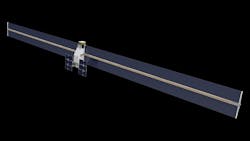NASA funds demo for 3D printed parts to be made and assembled in space
WASHINGTON - NASA has awarded a $73.7 million contract to Made In Space, Inc. of Mountain View, California, to demonstrate the ability of a small spacecraft, called Archinaut One, to manufacture and assemble spacecraft components in low-Earth orbit. The in-space robotic manufacturing and assembly technologies could be important for America's Moon to Mars exploration approach.
Through a private-public partnership with NASA, Made In Space, Inc. will demonstrate the ability of a small spacecraft, called Archinaut One, to manufacture and assemble spacecraft components in low-Earth orbit. Archinaut One is expected to launch on a Rocket Lab Electron rocket from New Zealand no earlier than 2022. Once it’s positioned in low-Earth orbit, the spacecraft will 3D-print two beams that extend 32 feet (10 meters) out from each side of the spacecraft. As manufacturing progresses, each beam will unfurl two solar arrays that generate up to five times more power than traditional solar panels on spacecraft of similar size.
Through a private-public partnership with NASA, Made In Space, Inc. will demonstrate the ability of a small spacecraft, called Archinaut One, to manufacture and assemble spacecraft components in low-Earth orbit. Archinaut One is expected to launch on a Rocket Lab Electron rocket from New Zealand no earlier than 2022. Once it’s positioned in low-Earth orbit, the spacecraft will 3D-print two beams that extend 32 feet (10 meters) out from each side of the spacecraft. As manufacturing progresses, each beam will unfurl two solar arrays that generate up to five times more power than traditional solar panels on spacecraft of similar size.
"In-space robotic manufacturing and assembly are unquestionable game-changers and fundamental capabilities for future space exploration," said Jim Reuter, associate administrator of NASA's Space Technology Mission Directorate. "By taking the lead in the development of this transformative technology, the United States will maintain its leadership in space exploration as we push forward with astronauts to the Moon and then on to Mars."
The potential of these technologies is profound and includes such benefits as:
- Enabling remote, in-space construction of communications antennae, large-scale space telescopes and other complex structures;
- Enabling small satellites to deploy large surface area power systems and reflectors that currently are reserved for larger satellites;
- Eliminating spacecraft volume limits imposed by rockets; and,
- Avoiding the inherent risk of spacewalks by performing some tasks currently completed by astronauts.
Made In Space began working on Archinaut as a ground demonstration in 2016 and, just a year later, successfully 3D-printed structural beams in a unique NASA facility that mimics the conditions of space. In a thermal vacuum chamber at the agency's Ames Research Center in California's Silicon Valley, they were able to prove the printing equipment and printed hardware can withstand the pressure, temperature, and other rigors of space.
The Archinaut team includes Made In Space, Northrop Grumman of Falls Church, Virginia, Ames, and NASA's Jet Propulsion Laboratory in Pasadena, California. NASA's Technology Demonstration Missions program within the Space Technology Mission Directorate matures groundbreaking technologies to extend mission capabilities as well as government and commercial opportunities in space. The program is based at NASA's Marshall Space Flight Center in Huntsville, Alabama.
To learn more about NASA's investments in space technology, please visit: https://www.nasa.gov/spacetech.
